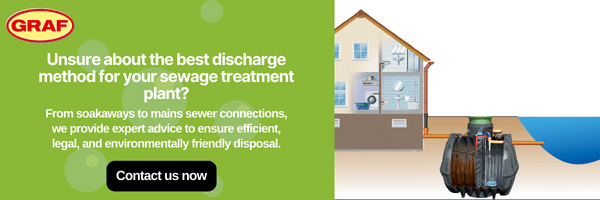When you are installing a sewage treatment plant you will need to thing about where the effluent is going to go once it has been treated inside the system. There are 3 mains methods of discharge that are available.
Discharging into a soakaway
This is the most common method as it is a tried and tested solution that many installers use when it comes to installing either a packaged treatment plant or septic tank. A soakaway is simply a field of perforated pipe, wrapped in geotextile. surrounded by gravel and then covered with spoil. This method is also preferred by building control and the environment agency as it the water to dissipate over a large surface area.
Discharging into a watercourse
This method of discharge can only be used if you have installed a sewage treatment plant as the quality of effluent being discharged from the tank is good enough to safely enter a watercourse without causing any damaged to the local environment. In order to do this you will need to receive a permit from building control or your local environment agency as you may be living in a water protection zone and you won’t be able to discharge into it.
Discharging into a mains sewer
If you don’t have the space to install a soakaway and you don’t have a watercourse close enough to discharge into then your only other option would be to install a pumped outlet to your treatment plant which would be able to pump the effluent from your tank to the local mains sewer. This can be very costly depending on how far the mains sewer is.
Are soakaway crates legal to use for a septic tank?
Unfortunately, soakaway crates aren’t legal to use as a soakaway for a septic tank or treatment plant. Even though they can be used as a soakaway for both rainwater and stormwater purposes they can’t be used as part of soakaway for a sewage system as compared to a normal perforated pipe soakaway the water would dissipate into the ground in a more concentrated area, whereas a normal soakaway would have a larger surface area.
Can a soakaway get blocked?
If you are putting the wrong items down your toilet and drains into your septic tank or treatment plant, then these items could as a result block your soakaway. These items include wipes, nappies, cotton buds, etc, which can all block a soakaway. Here’s list of items that you can and can’t flush down the toilet and if you have any questions about any of the items please contact us to discuss further.
A soakaway can also become blocked if the solids or sludge in the tank isn’t removed. Over time the amount of sludge inside the tank will continue to build up so it is important that you organise for septic tank emptying company to come in and remove the sludge inside the system. If you don’t organise this regularly then the sludge can discharge into the soakaway and in turn block it.



